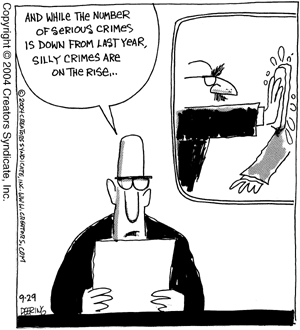
Measuring crime and criminal behavior
Quiz
on reading assignment.
Lecture: One of the things I always tell criminology students is that in order to get the most out of this class you must begin by erasing from your mind everything you think you know about crime, why people commit crime, how to prevent people from committing crime, and what to do with people after they commit crime. Start with a clean slate and open your mind to what the evidence tells us about these issues, rather than what you have been told, what "common sense" would have you believe, or what you would like to be true. Criminologists strive for empirical (based on careful observation or experiment) answers to these questions and not common sense answers which are often unreliable.
In
order to understand how we obtain empirical evidence, we must know some
terminology. Suppose we want to know a little more about domestic
violence. We do some preliminary observation and arrive at a theory, which is a starting point for our data collection, and a hypothesis,
which is a testable question. The hypothesis may be that young
women with children are more likely to be victims of domestic violence
than young women without children. Non-scientists often condemn
the concept of a hypothesis with the argument that it predisposes the
researcher to a conclusion that fits the theory. This
may be true for unethical researchers, but in reality, the hypothesis
is a requirement, because without it, the subsequent research would
have no focus. We would just wander aimlessly through data
without a purpose, in the hope of stumbling across a conclusion, and
that is not scientific.
First, ask yourself if the research has value. What can we gain
from answering this question? A lot, actually. If we find
that young women with children are more likely to be abused, we might
offer domestic violence information to this target group in pre-natal
clinics. We may want to give police officers, judges, and
probation officers more training in offering services to young women
with children and survey local women's shelters to make sure they are
providing adequate space for women with children.
Once the theory is established, we identify the group we want to study, or the population. The population are all of the people who fit the class we are studying, in this case, all young women who are victims of domestic violence. We cannot find them all. Many cases of domestic violence are not reported and of those reported, the numbers are overwhelming, so we need to pare down our population to a manageable size, or a sample of the population. Let's call our sample the young females who reported domestic violence in Sacramento County in the last six months. This is still a large group, so let's now take a random sample of that group. We will get a list from the superior court of all the sample members (let's say that number is 300), then divide that by the number we can effectively manage, say 100. We can then select every third member on the sample list to compose our random sample. A random sample is important, because we want this sample to represent the population, and any artificial terms (say only women who are easy to contact) could introduce variables that would not accurately show the character of the population.
We could then create a survey and ask each woman questions to help answer our hypothesis, which would create primary data (data we collected). We might also look to see if a data set had already been collected that we could then collate and interpret, such as by the court, a domestic violence project, or the government. That would be secondary data.
Once
the data are ("data" is plural; the singular is "datum") collected, we
may use statistical methods to see if our hypothesis is correct or not
and draw a conclusion. It is no disappointment if our hypothesis
is incorrect. Either way, we can use the information to create a
new theory and the process begins again with new research.
Secondary data: In this course we will be looking at secondary data, which is available from many sources. One of the best is the Sourcebook, which is a government collection of data primarily from the Uniform Crime Report (UCR) and the National Crime Victimization Survey (NCVS). Go there and look around at the different types of tables available. The Bureau of Justice Statistics compiles reports based on data is collects. Look at the left column and select the topic you are interested in, e.g. corrections, courts, law enforcement, or victims. For our topic, click Victims, then Victim Characteristics, then Female Victims of Violence, then click thepdf for the report.
The National Center for Juvenile Justice
is a private research center with a lot of good information for those
wanting to know about juveniles, and the California Department of
Correction and Rehabilitation (CDCR) has research data on offenders and recidivism rates. Even the Department of Motor Vehicles has a website full of research.
In class activity: In the computer lab, go to each of the sites above, look around at what they offer, and then find one more source for criminal justice research data to share with the class.
Reading
Assignment for THIS week:
Text, Chapter 2
© Christopher Bruno